Multi-Objective Coordinated Planning of Distributed Generation and AC/DC Hybrid Distribution Networks Based on a Multi-Scenario Technique Considering Timing Characteristics
Abstract
1. Introduction
2. The Construction of a Multi-Scenario with Timing Characteristics Considering the DG Output and Load Fluctuation
2.1. Analysis of the Timing Characteristics of the DG Output and Load Fluctuation
2.2. Multi-Scenario Construction Based on Time-Phasing and Hybrid Clustering
- (1)
- Initialize the degree of membership matrix U, introduce the fast climbing function method [54], and determine the number of initial clustering c and the initial clustering centre vi;
- Define the pan type of the hill-climbing function:where α is a positive number that represents the effect for value M that is decided by the distance form of vi. The larger the value is, the more concentrated the data is, the finer the classification is, and the larger the M value is. Therefore, the clustering centre can be selected with a larger M value.
- Select the sample sequentially, determine the tth hill-climbing function, and obtain the maximum value of each hill-climbing function and its corresponding load sample value x2*:where is the tth hill-climbing function. and are the t − 1th hill-climbing function and its maximum value, respectively.
- Repeat step b until satisfying the convergence condition , where δ is the convergence coefficient of the classification, which is a small positive number. The clustering number c is the total number of clustering iterations before the convergence is finished, and the initial clustering centre vi is the maximum sample value xt* of the hill-climbing function in each clustering process.
- (2)
- Determine the weighting index w, which determines the fuzzy degree of the final clustering effect as follows:where Jw(U,V) represents the objective function; that is, the distance weighted sum of squares of each sample to all clustering centres is defined aswhere vi is the ith vector of the clustering centre and uij is the degree of membership of the jth sample for the ith clustering centre.
- (3)
- Update the clustering centre and the degree of membership matrix as follows:where xi (i = 1, 2, 3, …, c) is the set of ith load classification.
- (4)
- Use Equation (9) to calculate the objective functions.
- (5)
- Determine whether the iteration error of the two iterations of the objective function ∆Jw(U,V) is less than the given positive number ε, and if it is not satisfied, return to step 3. Otherwise, the clustering process ends.
3. The Power Flow Calculation of the AC/DC Hybrid Distribution Network with VSC-MTDC
3.1. The Power Flow Calculation with VSC-MTDC
3.2. The Power Flow Calculation of the AC/DC Hybrid Distribution Network with VSC-MTDC Based on Improved Forward-Backward Sweep
4. The Multi-Objective Coordinated Planning of the AC/DC Hybrid Distribution Network Based on the Multi-Scenario Technique Considering Timing Characteristics
4.1. Objective Functions
4.2. Constraint Conditions
4.3. Model Solution
- (1)
- Input the original data for the planning, encode the grid frame and initialize the population, randomly generate N populations and calculate the fitness values and rank in descending order according to Equations (21)–(29). Take the individual with the greatest fitness as the first centre of the niche, marked as Sc.
- (2)
- Measure the fitness increment Δfi of each individual and compare it with a pre-set increment threshold Δf. If the fitness rate exceeds the threshold, the distance from the individual to Sci can be used as the niche radius dci. The Δfi is as follows:
- (3)
- For other unlabelled individuals, reselect the individuals with the greatest fitness from the remaining individuals as niche centres, and repeat processes (1) and (2) until all individuals are marked.
- (4)
- The adaptive selection, crossover and mutation by means of Equations (37) and (38) are used to calculate the fitness value of the new generation population, and then, the average fitness value of each niche population is calculated according to Equation (39).where α and β are the constant parameters; pc1 and pc2 represent the minimum and maximum of the crossover rate, respectively; pm1 and pm2 represent the minimum and maximum values of the variance, respectively; fmax is the largest fitness value of the population; favg is the average fitness of each population; f′ is the larger fitness value of the two individuals to be crossed; and f is the individual fitness value to be mutated.
- (5)
- Use the penalty function of Equations (30)–(34) and handle the individuals with a lower fitness value by niche elimination. According to the hamming distance between the individuals, update the new fitness values of the population and arrange them in descending order;
- (6)
- Determine whether the number of iterations reaches the upper limit, if it is not satisfied, return to step (2), and if it is satisfied, then the iteration process is finished, and the non-inferior solution set will be output.
- (7)
- Calculate the degree of membership of non-inferior for each objective function according to Equation (40) as follows:where gij is the jth objective values of the ith solution in the non-inferior solution set and and are the maximum and minimum values of the objective j, respectively.
- (8)
- Weight the objective function by variance according to Equation (41) as follows:where wj is the weight of the objective j, M is the number of the objective function, and N is the number of the non-inferior solution set.
- (9)
- According to Equation (42), calculate the priority degree of each solution in the non-inferior solution set, and output the particle with the greatest degree that is the compromised optimal solution as follows:
5. Example Analysis
5.1. The Construction and Analysis of a Multi-Scenario
5.2. The Planning of the AC/DC Hybrid Distribution Network Based on Multi-Scenario Technique Consideration Timing Characteristics
5.2.1. The Overview Example and Parameter Analysis
5.2.2. The Planning Result Analysis
6. Conclusions
Acknowledgments
Author Contributions
Conflicts of Interest
Abbreviations
| DG | Distributed generation |
| DN | Distributed networks |
| AC | Alternating current |
| DC | Direct current |
| EVs | Electric Vehicles |
| DS | Distributed storage |
| ATC | available transfer capability |
| HVDC | High Voltage Direct Current |
| GAT | General Analytical Technique |
| RDSs | Radial Distribution Systems |
| SPPVSs | Single-Phase Photovoltaic Systems |
| PAT | Proposed Analytical Technique |
| BFGEs | Biomass-fueled gas engines |
| FCM | Fuzzy C means |
| VSC-MTDC | Voltage source converter-multi terminal direct current |
References
- Whaite, S.; Grainger, B.; Kwasinski, A. Power Quality in DC Power Distribution Systems and Microgrids. Energies 2015, 8, 4378–4399. [Google Scholar] [CrossRef]
- Gao, Y.; Yang, W.; Zhu, J.; Ren, J.; Li, P. Evaluating the Effect of Distributed Generation on Power Supply Capacity in Active Distribution System Based on Sensitivity Analysis. Energies 2017, 10, 1473. [Google Scholar] [CrossRef]
- Montoya-Bueno, S.; Muñoz-Hernández, J.I.; Contreras, J. Uncertainty management of renewable distributed generation. J. Clean. Prod. 2016, 138, 103–118. [Google Scholar] [CrossRef]
- Monadi, M.; Rouzbehi, K.; Candela, J.I.; Rodriguez, P. Chapter 11-DC Distribution Networks: A Solution for Integration of Distributed Generation Systems. In Distributed Generation Systems; Elsevier: Amsterdam, The Netherlands, 2017; pp. 509–561. ISBN 978-0-12-804208-3. [Google Scholar]
- Xue, S.; Lian, J.; Qi, J.; Fan, B. Pole-to-Ground Fault Analysis and Fast Protection Scheme for HVDC Based on Overhead Transmission Lines. Energies 2017, 10, 1059. [Google Scholar] [CrossRef]
- Jialiang, W.; Rui, W.; Chang, P.; Yu, W. Analysis of DC Grid Prospects in China. Proc. CSEE 2012, 32, 7–12. [Google Scholar]
- Hakala, T.; Lahdeaho, T.; Jarventausta, P. Low voltage DC distribution–utilization potential in a large distribution network company. IEEE Trans. Power Deliv. 2015, 30, 1694–1701. [Google Scholar] [CrossRef]
- Younus, S.A.M.; Nardello, M.; Tosato, P.; Brunelli, D. Power Controlling, Monitoring and Routing Center Enabled by a DC-Transformer. Energies 2017, 10, 403. [Google Scholar] [CrossRef]
- Hernandez, J.C.; Sanchez, F. Electric Vehicle Charging Stations Fed by Renewables: PV and Train Regenerative Braking. IEEE Lat. Am. Trans. 2016, 14, 3262–3269. [Google Scholar] [CrossRef]
- Liu, X.; Dai, X.; Li, M. Research on the home energy management system based on the microgrid technology. Power Syst. Prot. Control 2017, 45, 66–72. [Google Scholar]
- Diaz, N.L.; Dragičević, T.; Vasquez, J.C.; Guerrero, J.M. Intelligent distributed generation and storage units for dc microgrids—A new concept on cooperative control without communications beyond droop control. IEEE Trans. Smart Grid 2014, 5, 2476–2485. [Google Scholar] [CrossRef]
- Sun, K.; Zhang, L.; Xing, Y.; Guerrero, J.M. A distributed control strategy based on dc bus signaling for modular photovoltaic generation systems with battery energy storage. IEEE Trans. Power Electron. 2011, 26, 3032–3045. [Google Scholar] [CrossRef]
- Wang, P.; Jin, C.; Zhu, D.; Tang, Y.; Loh, P.C.; Choo, F.H. Distributed control for autonomous operation of a three-port AC/DC/DS hybrid microgrid. IEEE Trans. Ind. Electron. 2015, 62, 1279–1290. [Google Scholar] [CrossRef]
- Guo, L.; Zhang, S.; Li, X.; Feng, Y. Hierarchical coordination control for DC microgrid considering time of-use price. Power Syst. Technol. 2016, 40, 1992–2000. [Google Scholar]
- Lu, X.; Liu, N.; Chen, Q.; Zhang, J. Multi-objective optimal scheduling of a DC micro-grid consisted of PV system and EV charging station. In Proceedings of the 2014 IEEE Innovative Smart Grid Technologies, Asia, Kuala Lumpur, Malaysia, 20–23 May 2014; pp. 487–491. [Google Scholar]
- Shaaban, M.F.; Eajal, A.A.; El-Saadany, E.F. Coordinated charging of plug-in hybrid electric vehicles in smart hybrid AC/DC distribution systems. Renew. Energy 2015, 82, 92–99. [Google Scholar] [CrossRef]
- Sechilariu, M.; Locment, F.; Wang, B. Photovoltaic Electricity for Sustainable Building. Efficiency and Energy Cost Reduction for Isolated DC Microgrid. Energies 2015, 8, 7945–7967. [Google Scholar] [CrossRef]
- Liu, X.; Wang, P.; Loh, P.C. A hybrid AC/DC microgrid and its coordination control. IEEE Trans. Smart Grid 2012, 2, 278–286. [Google Scholar]
- Ahmed, H.M.A.; Eltantawy, A.B.; Salama, M.M.A. A planning approach for the network configuration of ac-dc hybrid distribution systems. IEEE Trans. Smart Grid 2016, 99, 1–10. [Google Scholar] [CrossRef]
- Lotfi, H.; Khodaei, A. Hybrid AC/DC microgrid planning. Energy 2017, 118, 37–46. [Google Scholar] [CrossRef]
- Wei, J.; Li, G.; Zhou, M. Monte Carlo simulation and bootstrap method based assessment of available transfer capability in AC–DC hybrid systems. Int. J. Electr. Power Energy Syst. 2013, 53, 231–236. [Google Scholar] [CrossRef]
- Radwan, A.A.A.; Mohamed, A.R.I. Assessment and mitigation of interaction dynamics in hybrid AC/DC distribution generation systems. IEEE Trans. Smart Grid 2012, 3, 1382–1393. [Google Scholar] [CrossRef]
- Kurohane, K.; Senjyu, T.; Uehara, A.; Yona, A.; Funabashi, T.; Kim, C.H. A hybrid smart AC/DC power system. IEEE Trans. Smart Grid 2010, 1, 199–204. [Google Scholar] [CrossRef]
- Sasidharan, N.; Singh, J.G.; Ongsakul, W. An approach for an efficient hybrid AC/DC solar powered Homegrid system based on the load characteristics of home appliances. Energy Build. 2015, 108, 23–35. [Google Scholar] [CrossRef]
- Baboli, P.T.; Shahparasti, M.; Moghaddam, M.P.; Haghifam, M.R.; Mohamadian, M. Energy management and operation modelling of hybrid AC–DC microgrid. IET Gener. Transm. Distrib. 2014, 8, 1700–1711. [Google Scholar] [CrossRef]
- Ko, B.; Utomo, N.P.; Jang, G.; Kim, J.; Cho, J. Optimal Scheduling for the Complementary Energy Storage System Operation Based on Smart Metering Data in the DC Distribution System. Energies 2013, 6, 6569–6585. [Google Scholar] [CrossRef]
- Huang, Y.; Söder, L. Evaluation of economic regulation in distribution systems with distributed generation. Energy 2017, 126, 192–201. [Google Scholar] [CrossRef]
- Hernández, J.C.; Ruiz-Rodriguez, F.J.; Jurado, F. Modelling and assessment of the combined technical impact of electric vehicles and photovoltaic generation in radial distribution systems. Energy 2017, 141, 316–332. [Google Scholar] [CrossRef]
- Ruiz-Rodriguez, F.J.; Hernandez, J.C.; Jurado, F. Voltage unbalance assessment in secondary radial distribution networks with single-phase photovoltaic systems. Int. J. Electr. Power Energy Syst. 2015, 64, 646–654. [Google Scholar] [CrossRef]
- Hemmati, R.; Hooshmand, R.A.; Taheri, N. Distribution network expansion planning and DG placement in the presence of uncertainties. Int. J. Electr. Power Energy Syst. 2015, 73, 665–673. [Google Scholar] [CrossRef]
- Rabiee, A.; Soroudi, A.; Mohammadi-Ivatloo, B.; Parniani, M. Corrective Voltage Control Scheme Considering Demand Response and Stochastic Wind Power. IEEE Trans. Power Syst. 2014, 29, 2965–2973. [Google Scholar] [CrossRef]
- Ruiz-Rodríguez, F.J.; Hernández, J.C.; Jurado, F. Probabilistic Load-Flow Analysis of Biomass-Fuelled Gas Engines with Electrical Vehicles in Distribution Systems. Energies 2017, 10, 1536. [Google Scholar] [CrossRef]
- Ganguly, S.; Samajpati, D. Distributed Generation Allocation on Radial Distribution Networks under Uncertainties of Load and Generation Using Genetic Algorithm. IEEE Trans. Sustain. Energy 2015, 6, 688–697. [Google Scholar] [CrossRef]
- Soroudi, A. Possibilistic-Scenario Model for DG Impact Assessment on Distribution Networks in an Uncertain Environment. IEEE Trans. Power Syst. 2012, 27, 1283–1293. [Google Scholar] [CrossRef]
- Liu, K.Y.; Sheng, W.; Liu, Y.; Meng, X.; Liu, Y. Optimal sitting and sizing of DGs in distribution system considering time sequence characteristics of loads and DGs. Int. J. Electr. Power Energy Syst. 2015, 69, 430–440. [Google Scholar] [CrossRef]
- Gao, Y.; Liu, J.; Yang, J.; Liang, H.; Zhang, J. Multi-Objective Planning of Multi-Type Distributed Generation Considering Timing Characteristics and Environmental Benefits. Energies 2014, 7, 6242–6257. [Google Scholar] [CrossRef]
- Dong, L.; Chen, H.; Pu, T.; Wang, X. Multi-time Scale Dynamic Optimal Dispatch in Active Distribution Network Based on Model Predictive Control. Proc. CSEE 2016, 36, 4609–4616. [Google Scholar]
- Hao, X.; Wei, P.; Li, K. Multi-time Scale Coordinated Optimal Dispatch of Microgrid Based on Model Predictive Control. Autom. Electr. Power Syst. 2016, 40, 7–14. [Google Scholar]
- Li, R.; Gao, Y.; Cheng, H.; Liang, H. Two Step Optimal Dispatch Based on Multiple Scenarios Technique Considering Uncertainties of Intermittent Distributed Generations and Loads in the Active Distribution System. Proc. CSEE 2015, 35, 1657–1665. [Google Scholar]
- Soroudi, A.; Caire, R.; Hadjsaid, N.; Ehsan, M. Probabilistic dynamic multi-objective model for renewable and non-renewable distributed generation planning. IET Gener. Transm. Distrib. 2011, 5, 1173–1182. [Google Scholar] [CrossRef]
- Atwa, Y.M.; El-Saadany, E.F.; Salama, M.M.A.; Seethapathy, R. Optimal renewable resources mix for distribution system energy loss minimization. IEEE Trans. Power Syst. 2010, 25, 360–370. [Google Scholar] [CrossRef]
- Zou, K.; Agalgaonkar, A.P.; Muttaqi, K.M.; Perera, S. Distribution system planning with incorporating dg reactive capability and system uncertainties. IEEE Trans. Sustain. Energy 2012, 3, 112–123. [Google Scholar] [CrossRef]
- Suchitra, D.; Jegatheesan, R.; Deepika, T.J. Optimal design of hybrid power generation system and its integration in the distribution network. Int. J. Electr. Power Energy Syst. 2016, 82, 136–149. [Google Scholar] [CrossRef]
- Jain, N.; Singh, S.N.; Srivastava, S.C. A Generalized Approach for DG Planning and Viability Analysis under Market Scenario. IEEE Trans. Ind. Electron. 2013, 60, 5075–5085. [Google Scholar] [CrossRef]
- Yuan, W.; Wang, J.; Qiu, F.; Chen, C.; Kang, C.; Zeng, B. Robust Optimization-Based Resilient Distribution Network Planning against Natural Disasters. IEEE Trans. Smart Grid 2016, 7, 2817–2826. [Google Scholar] [CrossRef]
- Kazmi, S.A.A.; Shin, D.R. DG Placement in Loop Distribution Network with New Voltage Stability Index and Loss Minimization Condition Based Planning Approach under Load Growth. Energies 2017, 10, 1203. [Google Scholar] [CrossRef]
- Muke, B.; Wei, T.; Lu, Z.; Li, S. Multi-objective coordinated planning of distribution network incorporating distributed generation based on chance constrained programming. Trans. China Electrotech. Soc. 2013, 28, 346–354. [Google Scholar]
- Kazmi, A.A.; Dong, R.S.; Shahzad, M.K. Multi-Objective Planning Techniques in Distribution Networks: A Composite Review. Energies 2017, 10, 44. [Google Scholar] [CrossRef]
- Fang, C.; Zhang, X.; Cheng, H.; Zhang, S.; Yao, Z. Framework Planning of Distribution Network Containing Distributed Generation Considering Active Management. Power Syst. Technol. 2014, 38, 823–829. [Google Scholar]
- Zhang, S.X.; Cheng, H.Z.; Zhang, L.B.; Chen, K.; Long, Y. Multi-objective reactive power planning in distribution system incorporating with wind turbine generation. Power Syst. Prot. Control 2013, 41, 40–46. [Google Scholar]
- Liu, Z.; Wen, F.; Xue, Y.; Xin, J.; Ledwich, G. Optimal siting and sizing of distributed generators considering plug-in electric vehicles. Autom. Electr. Power Syst. 2011, 35, 11–16. [Google Scholar]
- Xu, L.; Sun, T.; Xu, J.; Sun, Y.Z.; Li, Z.S.; Lin, C.Q. Mid-and long-term daily load curve forecasting based on functional nonparametric regression model. Electr. Power Autom. Equip. 2015, 35, 89–94. [Google Scholar]
- Lei, J.; Yu, X. Fuzzy C-means Clustering-based Algorithm for the Analysis of Regional Electric Power Characteristics. J. Shanghai Univ. Electr. Power 2017, 33, 196–200. [Google Scholar]
- Kong, X.; Hu, Q.; Dong, X.; Zeng, Y.; Wu, Z. Load Data Identification and Correction Method with Improved Fuzzy C-means Clustering Algorithm. Autom. Electr. Power Syst. 2017, 41, 90–95. [Google Scholar]
- Beerten, J.; Cole, S.; Belmans, R. Generalized steady-state VSC MTDC model for sequential AC/DC power flow algorithms. IEEE Trans. Power Syst. 2012, 27, 821–829. [Google Scholar] [CrossRef]
- Fu, M.; Jin, H. Advanced Forward and Backward Sweep Algorithm for Radial Distribution Network Power Flow. J. Harbin Univ. Sci. Technol. 2014, 19, 105–109. [Google Scholar]
- Chen, Y.; Wang, Q.; Zhao, C.; Wei, T. Reliable distribution power flow calculation based on advanced forward and backward substitution method. J. Nanjing Norm. Univ. 2011, 8, 24–29. [Google Scholar]
- Liang, H.; Zhao, X.; Yu, X.; Gao, Y.; Yang, J. Study of power flow algorithm of AC/DC distribution system including VSC-MTDC. Energies 2015, 8, 8391–8405. [Google Scholar] [CrossRef]
- Chen, J.; Liao, X.; Wu, Y.; Chen, G.; Zhuang, X. Rao-Blackwellised SLAM based on niched genetic optimized method. Appl. Res. Comput. 2017, 34, 2368–2371. [Google Scholar]
- Wang, P.; Goel, L.; Liu, X.; Choo, F.H. Harmonizing AC and DC: A hybrid AC/DC future grid solution. IEEE Power Energy Mag. 2013, 11, 76–83. [Google Scholar] [CrossRef]

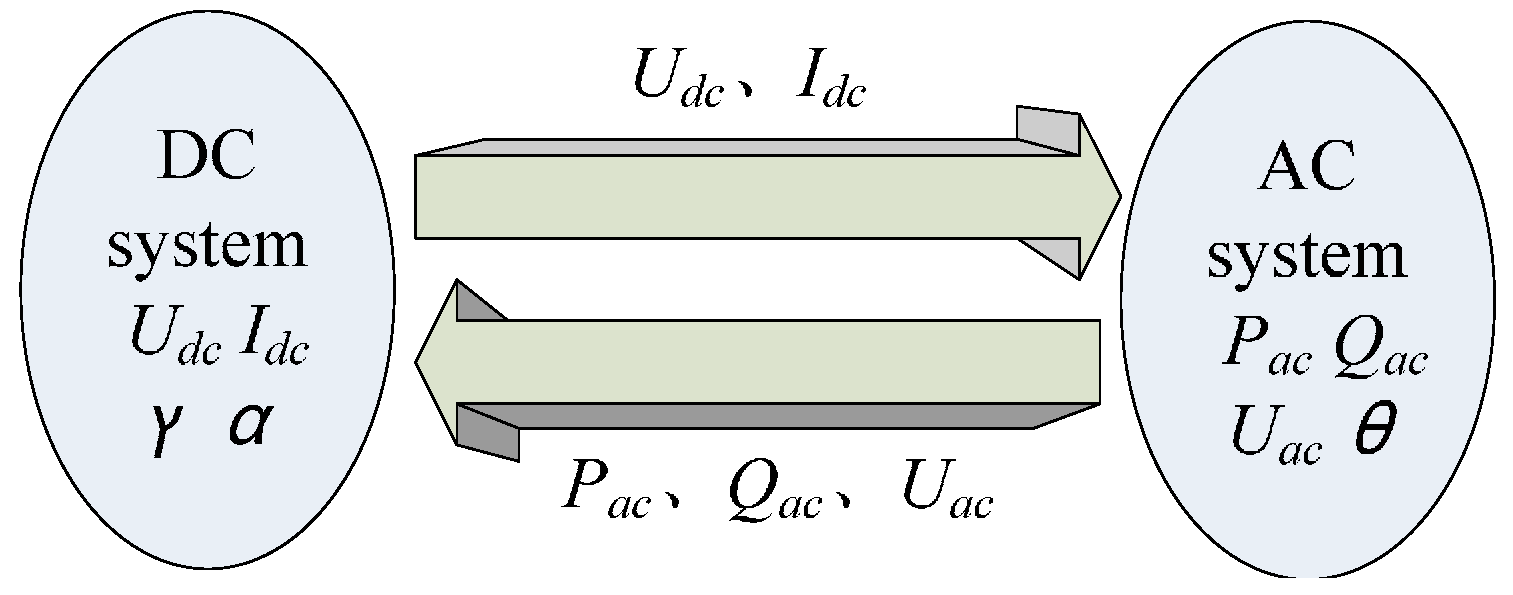
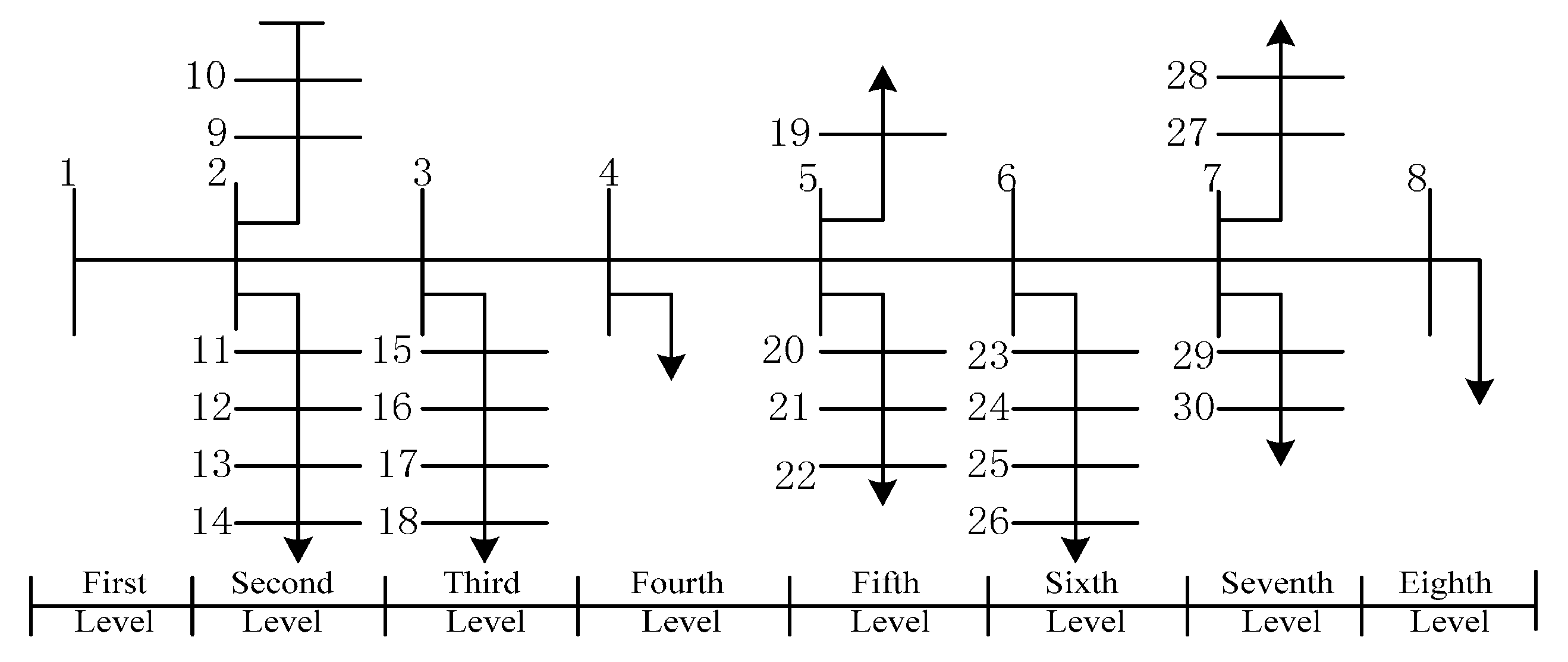
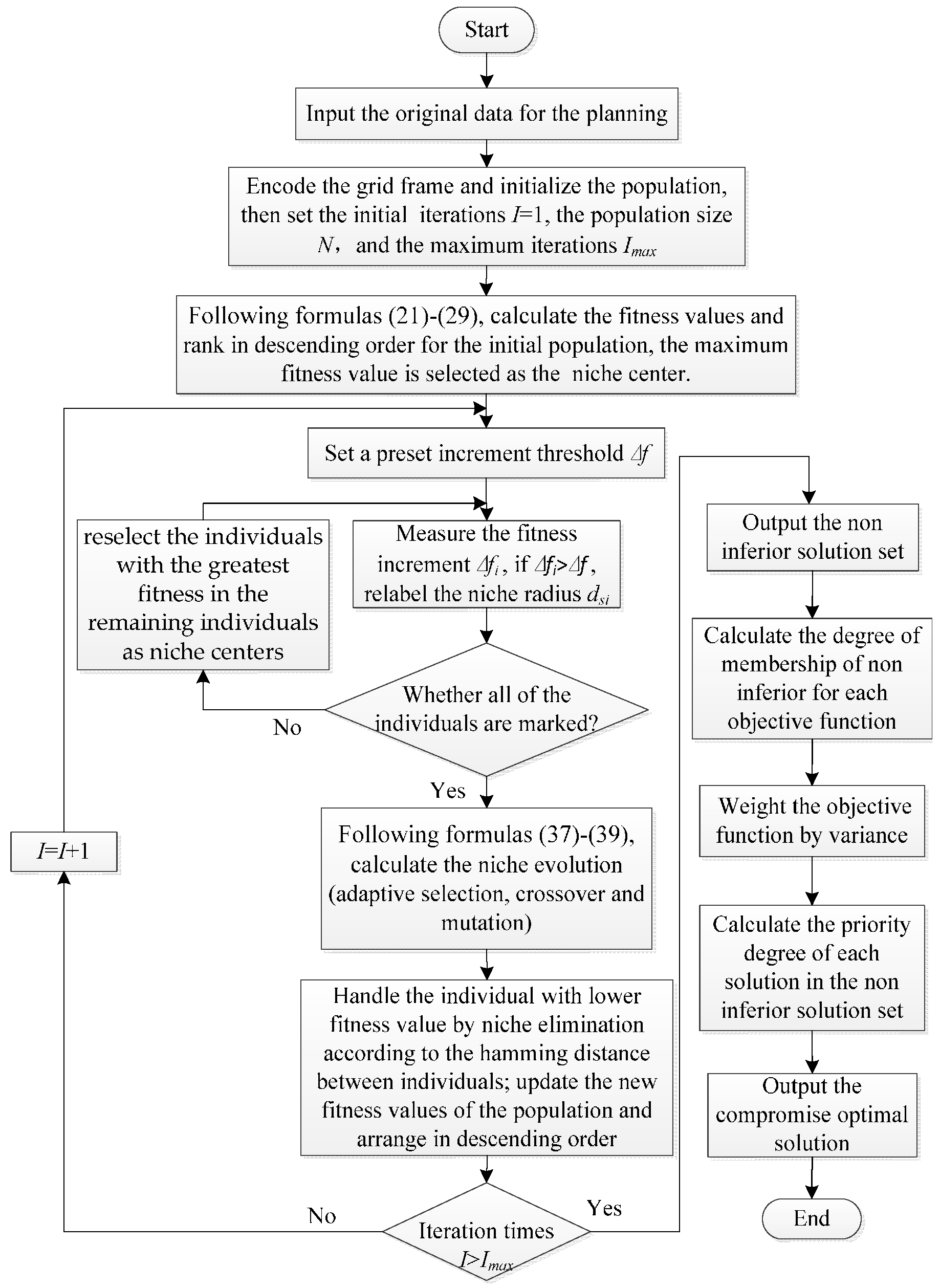
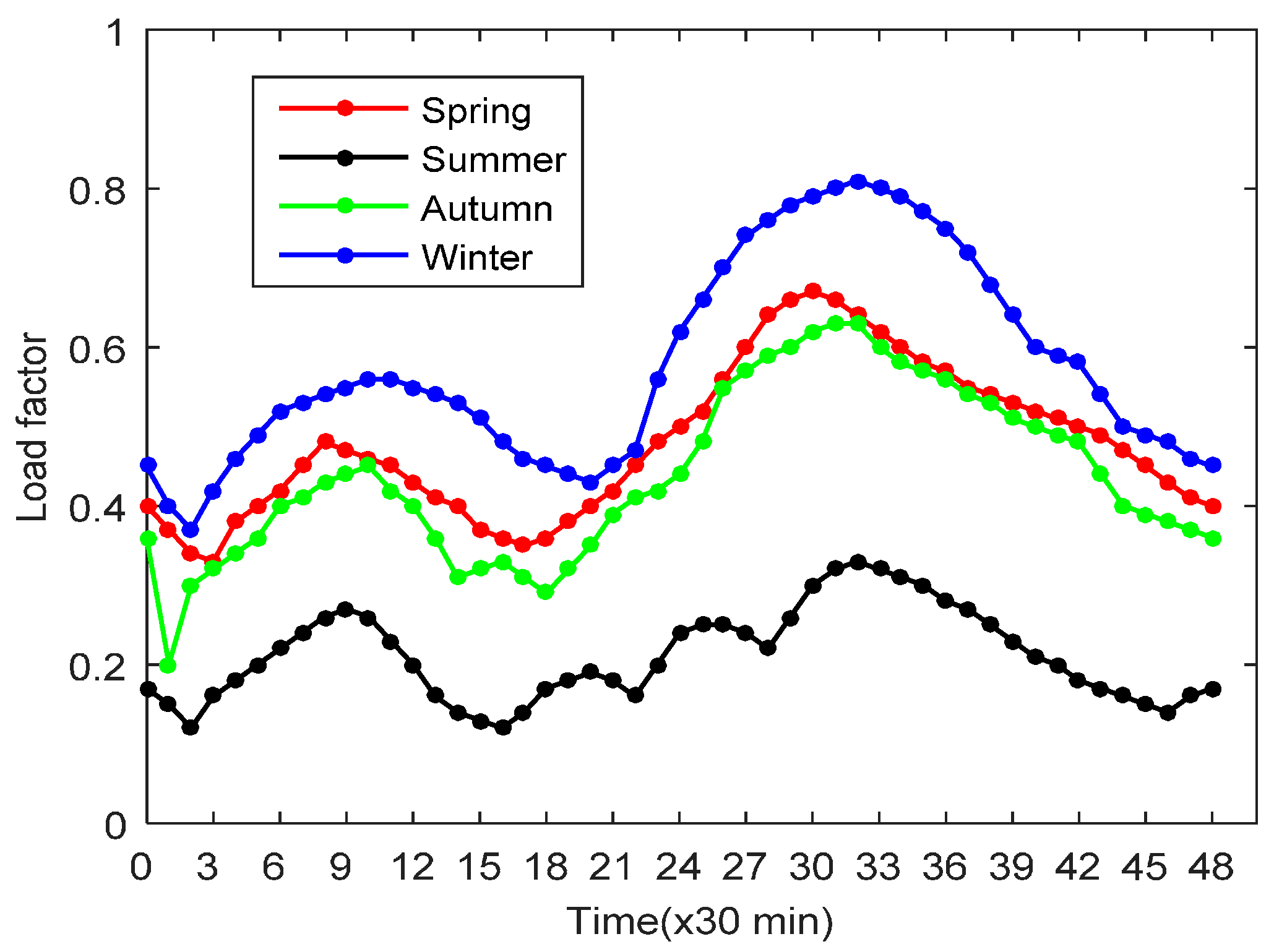
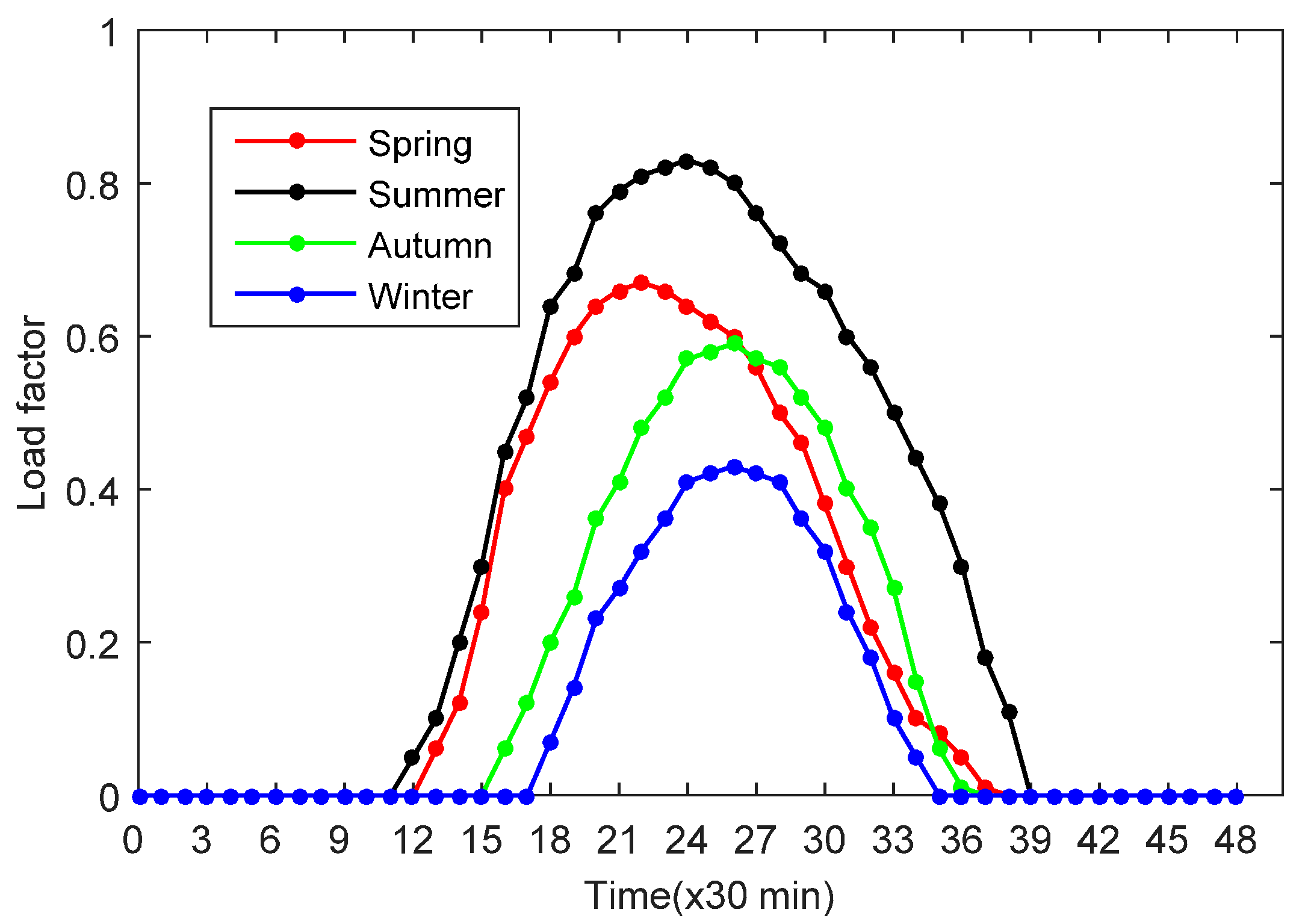
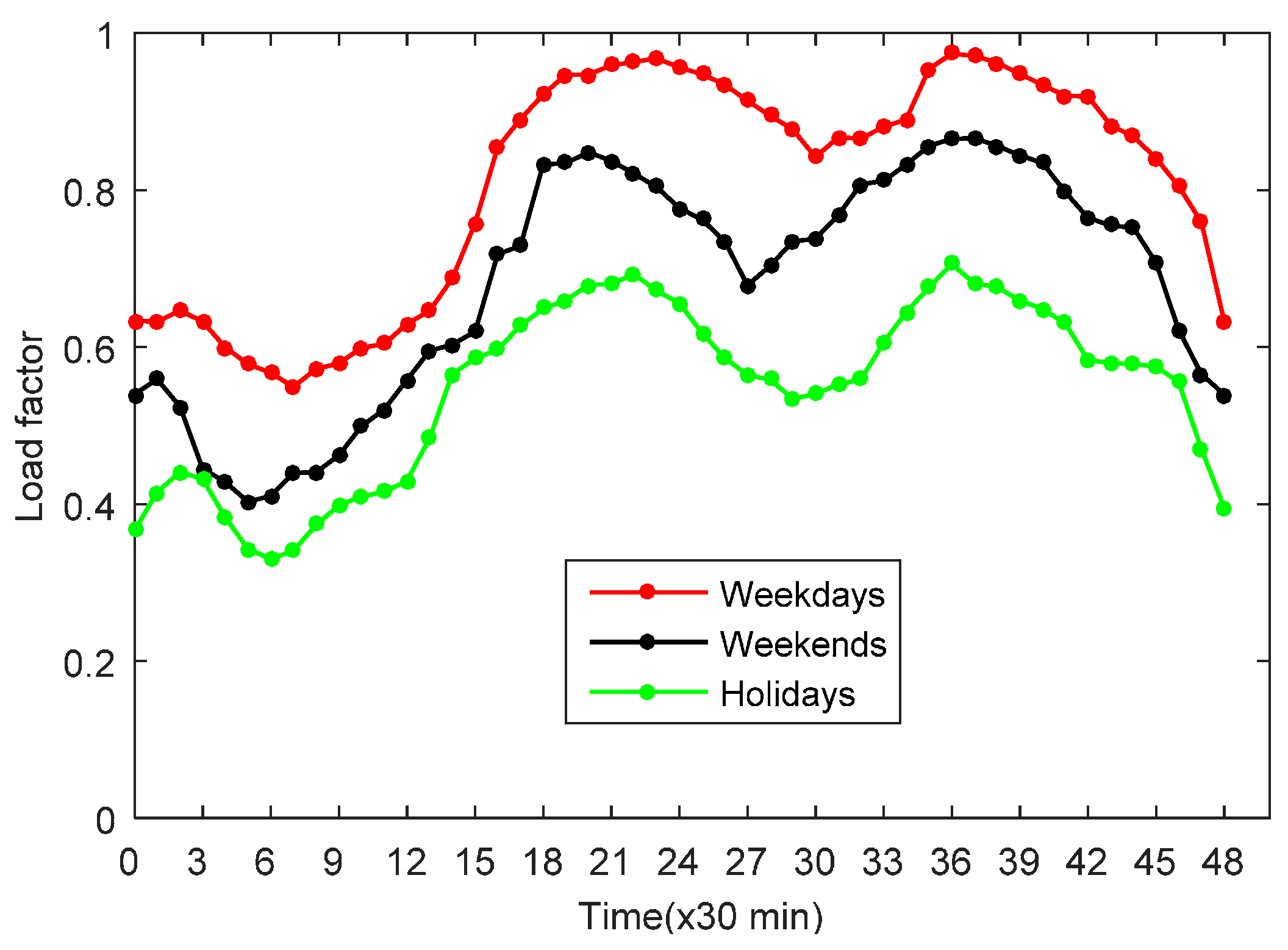
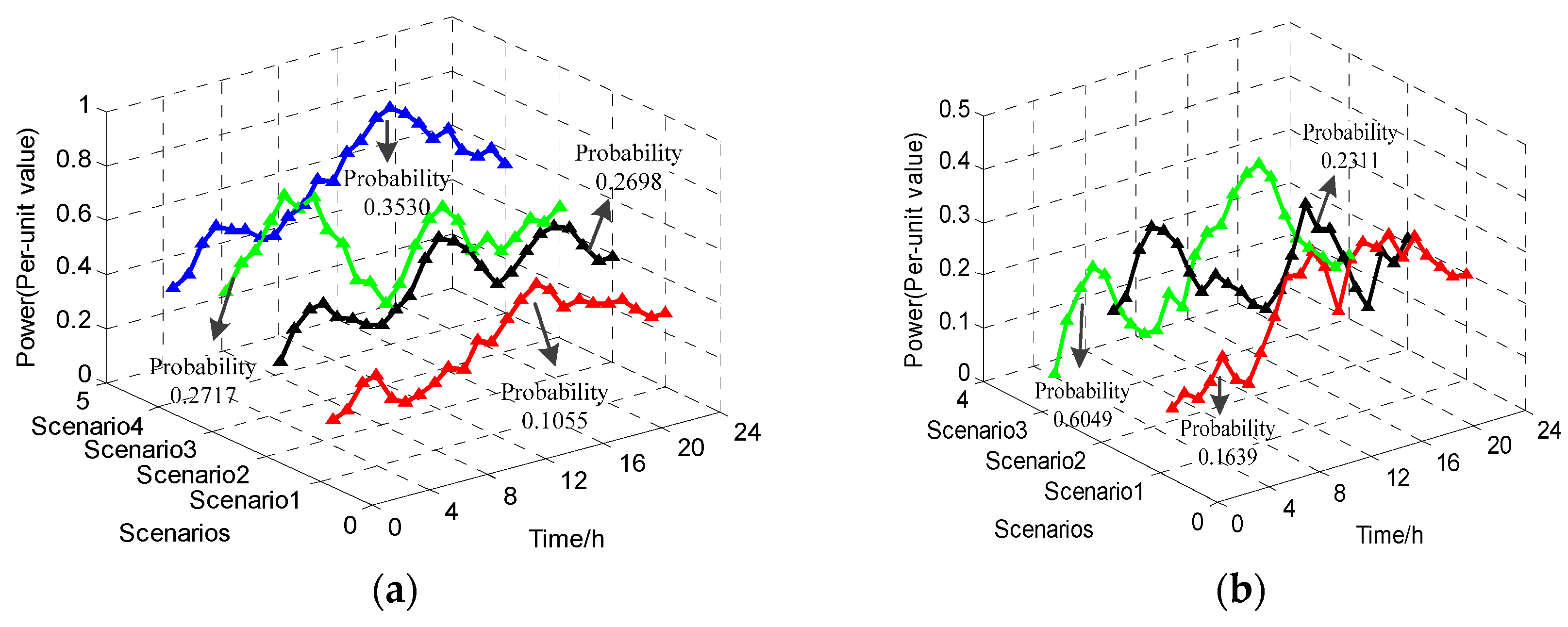
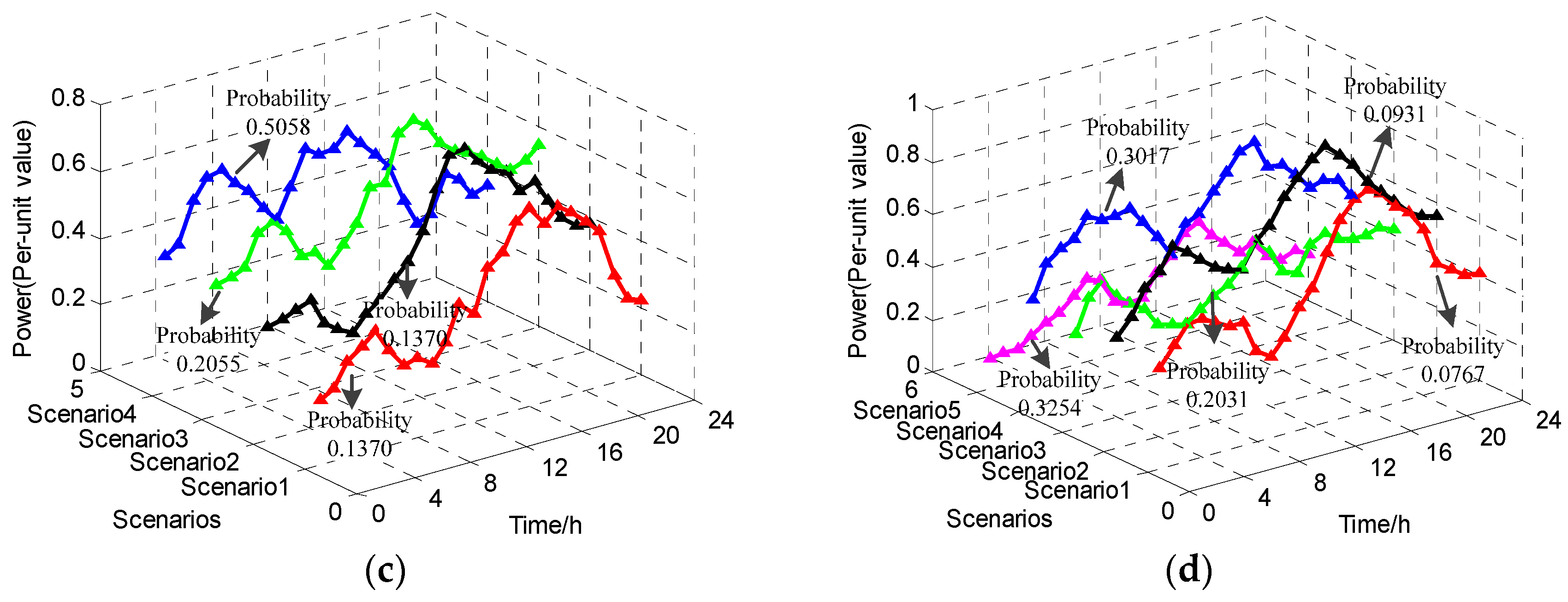
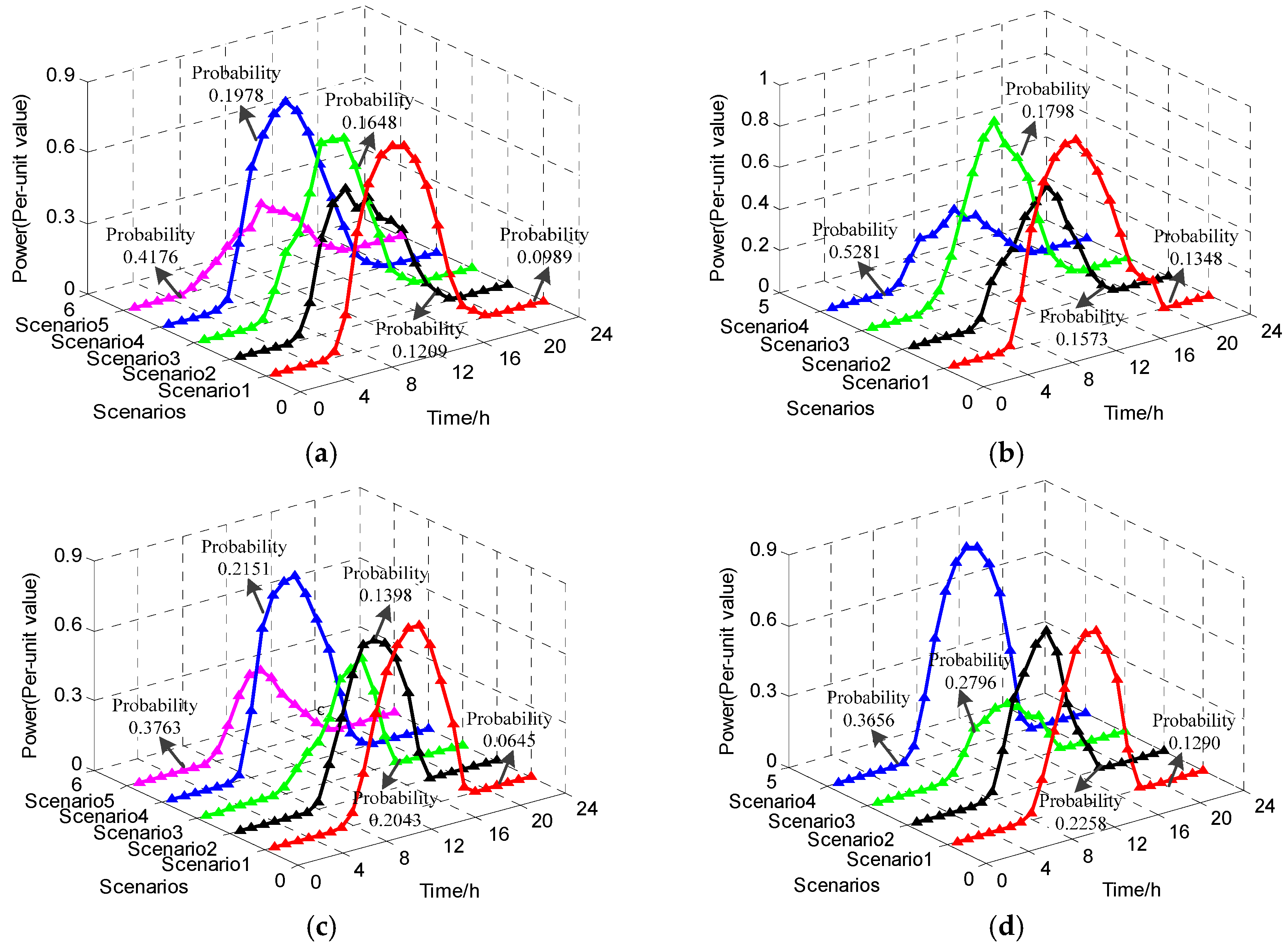
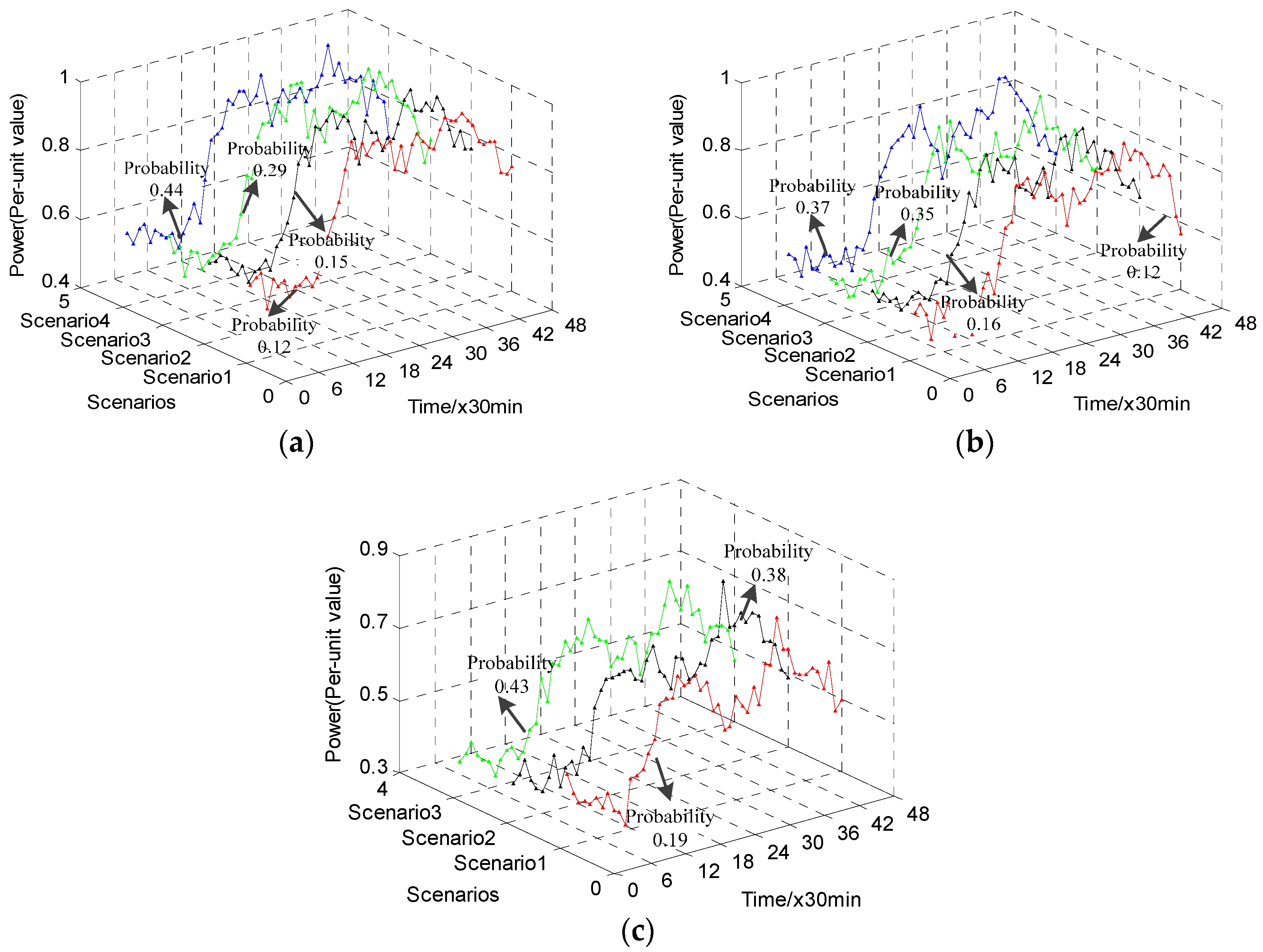

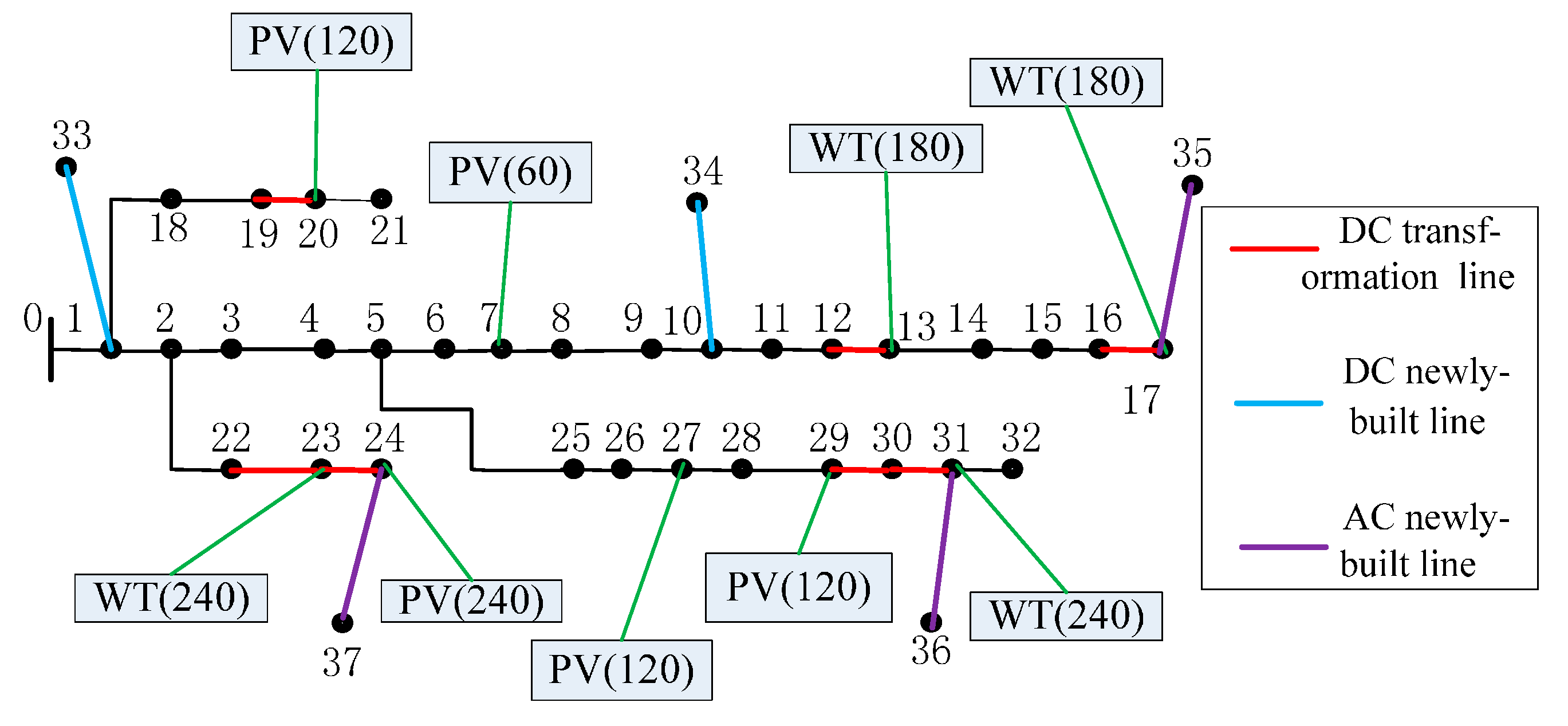
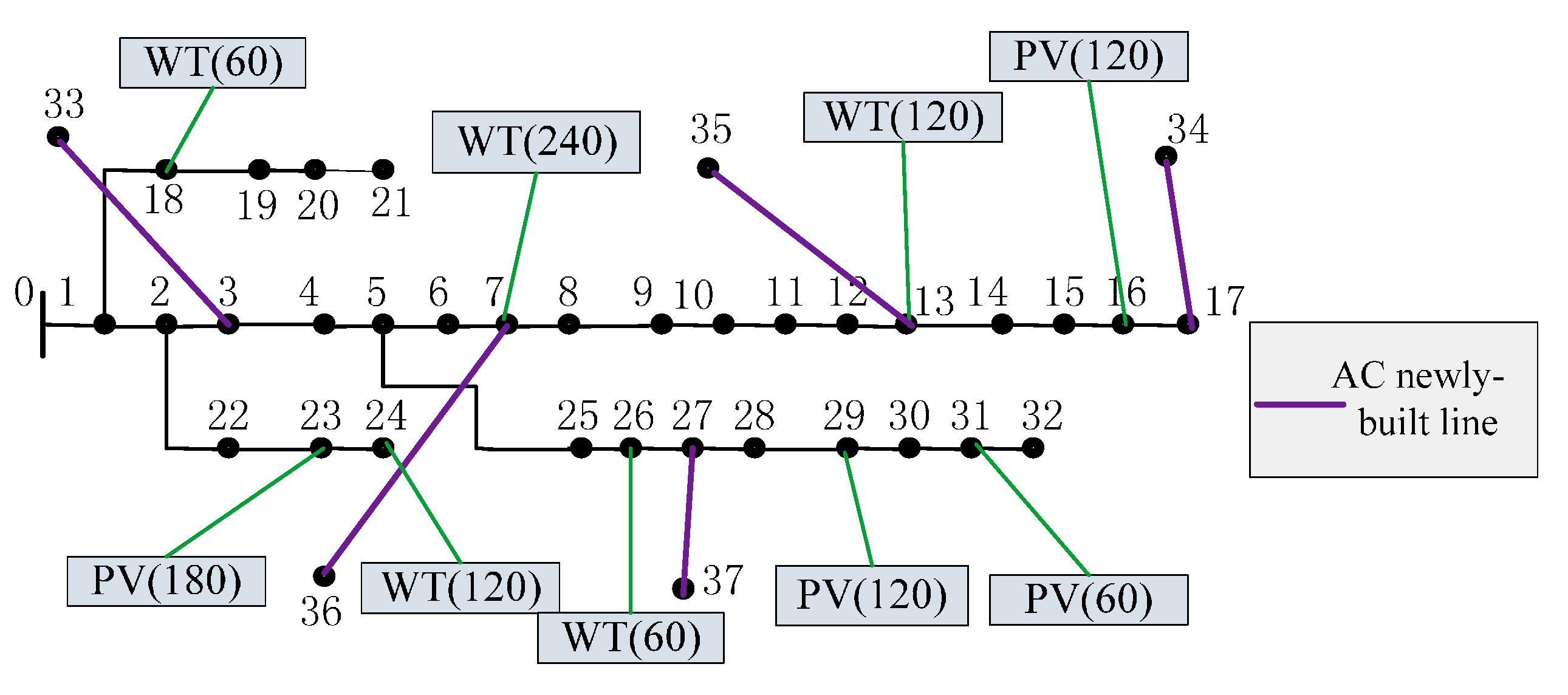
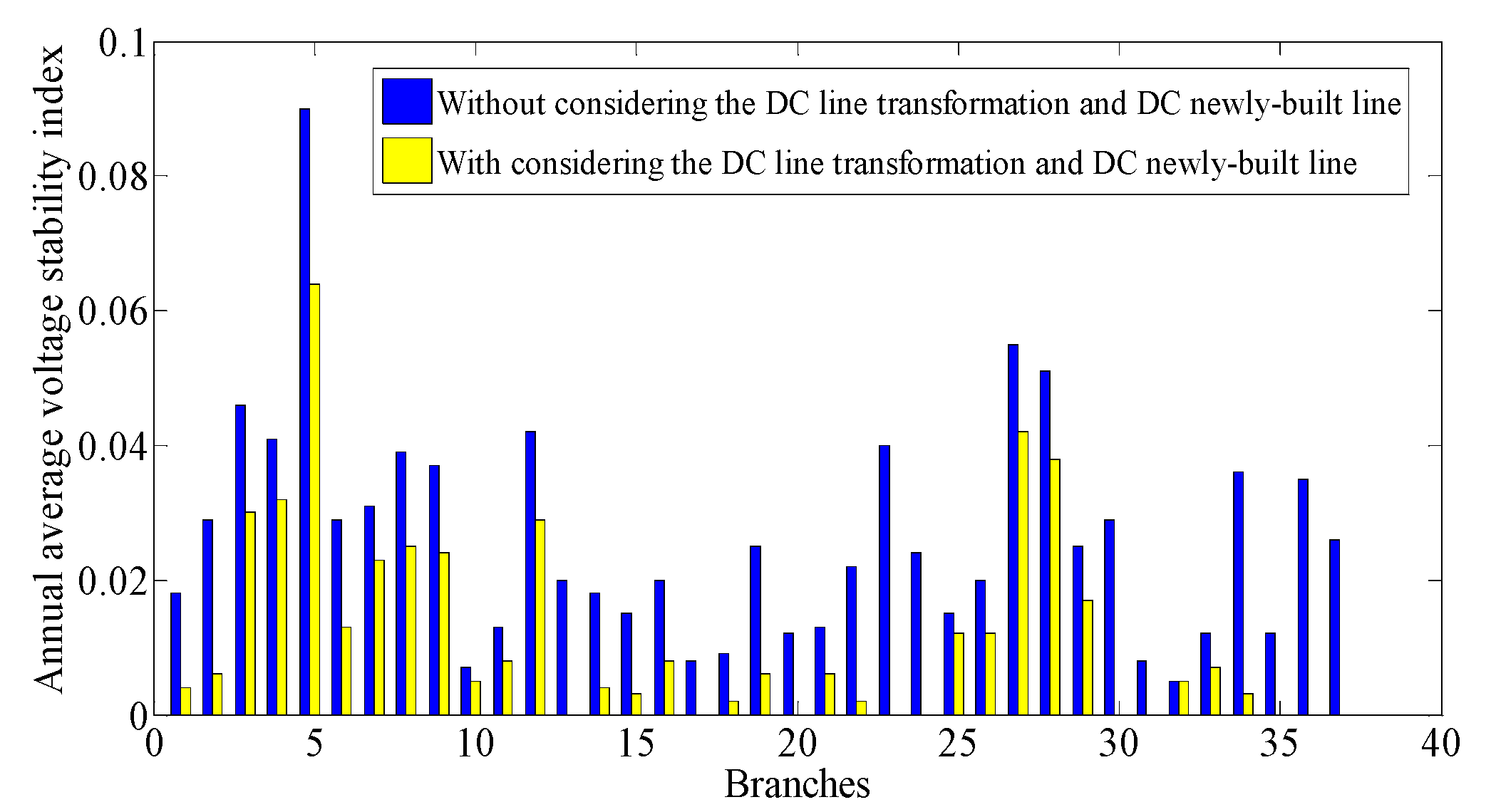
| Category | Weekdays | Weekends | Holidays |
|---|---|---|---|
| Spring | 4 × 5 × 4 = 80 | 4 × 5 × 4 = 80 | 4 × 5 × 3 = 60 |
| Summer | 3 × 4 × 4 = 48 | 3 × 4 × 3 = 36 | 3 × 4 × 3 = 36 |
| Autumn | 4 × 5 × 4 = 80 | 4 × 5 × 4 = 80 | 4 × 5 × 3 = 60 |
| Winter | 5 × 4 × 4 = 80 | 5 × 4 × 4 = 80 | 5 × 4 × 3 = 60 |
| Node | Proportion of DC Load | Node | Proportion of DC Load |
|---|---|---|---|
| 1 | 0% | 17 | 100% |
| 2 | 50% | 18 | 50% |
| 3 | 20% | 19 | 60% |
| 4 | 30% | 20 | 50% |
| 5 | 40% | 21 | 20% |
| 6 | 60% | 22 | 40% |
| 7 | 60% | 23 | 80% |
| 8 | 20% | 24 | 60% |
| 9 | 10% | 25 | 50% |
| 10 | 20% | 26 | 40% |
| 11 | 20% | 27 | 50% |
| 12 | 50% | 28 | 10% |
| 13 | 60% | 29 | 60% |
| 14 | 20% | 30 | 60% |
| 15 | 10% | 31 | 70% |
| 16 | 50% | 32 | 50% |
| DG Configuration (Node (DG Types, DG Capacity (kVA))) | DG Capacity (kVA) | DC Line Transformation | Newly Built DC Line |
|---|---|---|---|
| 7 (PV, 60) 13 (WT, 180) 17 (WT, 180) 20 (PV, 120) 23 (WT, 240) 24 (PV, 240) 27 (PV, 120) 29 (PV, 120) 31 (WT, 240) | WT: 840 PV: 660 Total capacity: 1500 | 12–13 16–17 19–20 22–23 23–24 29–30 30–31 | 33–1 (AC) 34–10 (AC) 35–17 (DC) 36–31 (DC) 37–24 (DC) |
| Each Objective Item | Numerical Value |
|---|---|
| Annual investment, operational and maintenance costs of the DG (million yuan) | 146.34 |
| The DC line transformation and newly built DC line costs (million yuan) | 1.325 |
| The converter of grid-connected DG cost (million yuan) | 0.32 |
| The converter of load connected cost (million yuan) | 3.102 |
| The converter on DC line cost (million yuan) | 26.6 |
| Annual economic cost (million yuan) | 177.6870 |
| Annual active network loss (MW·h) | 884.12 |
| Annual average voltage stability index | 0.062 |
| DG Configuration (Node (DG types, DG Capacity (kVA))) | DG Capacity (kVA) | DC line Transformation | Newly Built DC Line |
|---|---|---|---|
| 7 (WT, 240) 13 (WT, 120) 16 (PV, 120) 18 (WT, 60) 23 (PV, 180) 24 (WT, 120) 26 (WT, 60) 29 (PV, 120) 31 (PV, 60) | WT:600 PV:480 Total capacity: 1080 | / | 33–3 (AC) 34–17 (AC) 35–13 (AC) 36–7 (AC) 37–27 (AC) |
| Each Objective Item | Considering DC Line Transformation and Newly Built DC Line | Ignoring DC Line Transformation and Newly Built DC Line |
|---|---|---|
| Annual investment, operational and maintenance costs of the DG (million yuan) | 146.34 | 134.92 |
| The DC line transformation and newly built DC line costs (million yuan) | 1.325 | 1.283 |
| The converter of grid-connected DG cost (million yuan) | 0.32 | 23.34 |
| The converter of load connected cost (million yuan) | 3.102 | 24.245 |
| The converter on DC line cost (million yuan) | 26.6 | 0 |
| Annual economic cost (million yuan) | 177.6870 | 183.7880 |
| Annual active network loss (MW·h) | 884.12 | 1223.45 |
| Annual average voltage stability index | 0.062 | 0.091 |
© 2017 by the authors. Licensee MDPI, Basel, Switzerland. This article is an open access article distributed under the terms and conditions of the Creative Commons Attribution (CC BY) license (http://creativecommons.org/licenses/by/4.0/).
Share and Cite
Yang, Y.; Wang, X.; Luo, J.; Duan, J.; Gao, Y.; Li, H.; Xiao, X. Multi-Objective Coordinated Planning of Distributed Generation and AC/DC Hybrid Distribution Networks Based on a Multi-Scenario Technique Considering Timing Characteristics. Energies 2017, 10, 2137. https://doi.org/10.3390/en10122137
Yang Y, Wang X, Luo J, Duan J, Gao Y, Li H, Xiao X. Multi-Objective Coordinated Planning of Distributed Generation and AC/DC Hybrid Distribution Networks Based on a Multi-Scenario Technique Considering Timing Characteristics. Energies. 2017; 10(12):2137. https://doi.org/10.3390/en10122137
Chicago/Turabian StyleYang, Yongchun, Xiaodan Wang, Jingjing Luo, Jie Duan, Yajing Gao, Hong Li, and Xiangning Xiao. 2017. "Multi-Objective Coordinated Planning of Distributed Generation and AC/DC Hybrid Distribution Networks Based on a Multi-Scenario Technique Considering Timing Characteristics" Energies 10, no. 12: 2137. https://doi.org/10.3390/en10122137
APA StyleYang, Y., Wang, X., Luo, J., Duan, J., Gao, Y., Li, H., & Xiao, X. (2017). Multi-Objective Coordinated Planning of Distributed Generation and AC/DC Hybrid Distribution Networks Based on a Multi-Scenario Technique Considering Timing Characteristics. Energies, 10(12), 2137. https://doi.org/10.3390/en10122137





